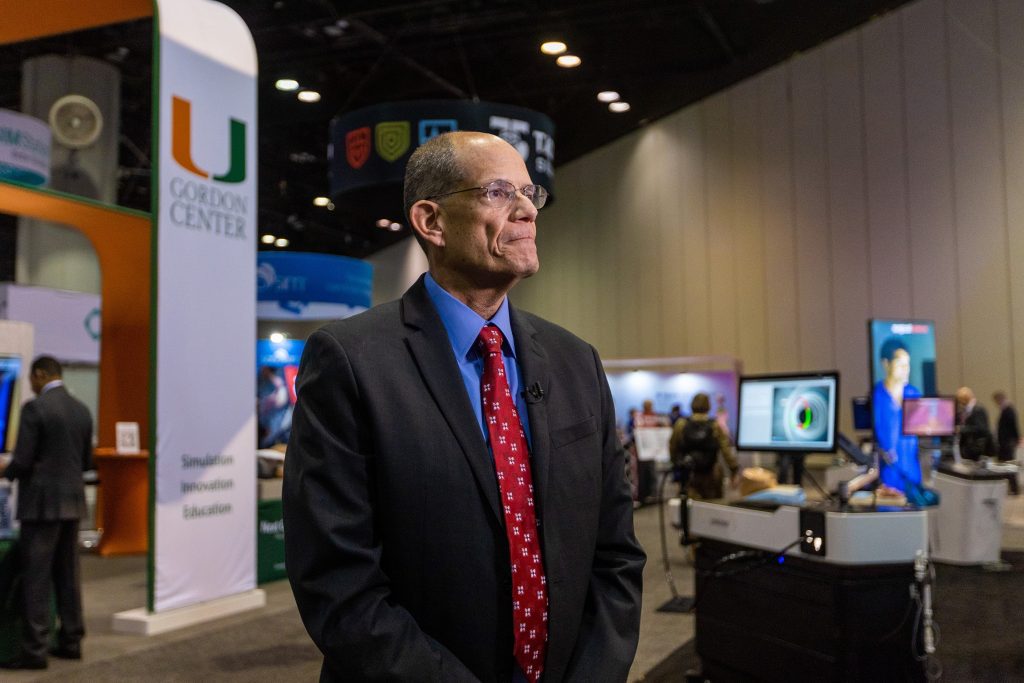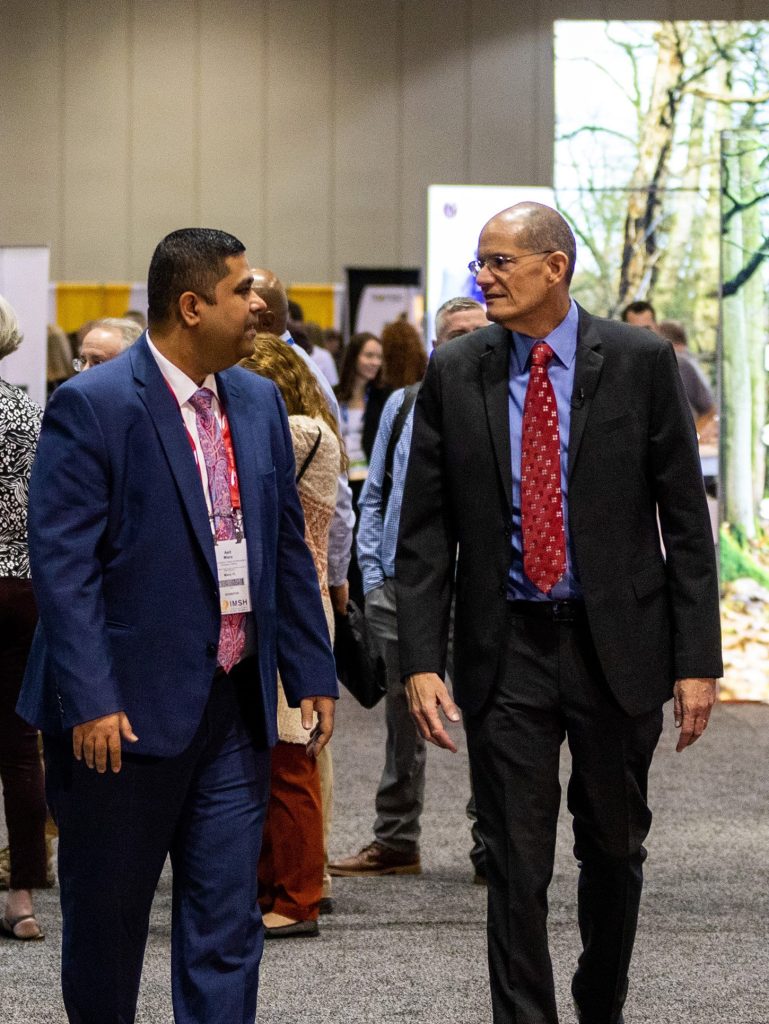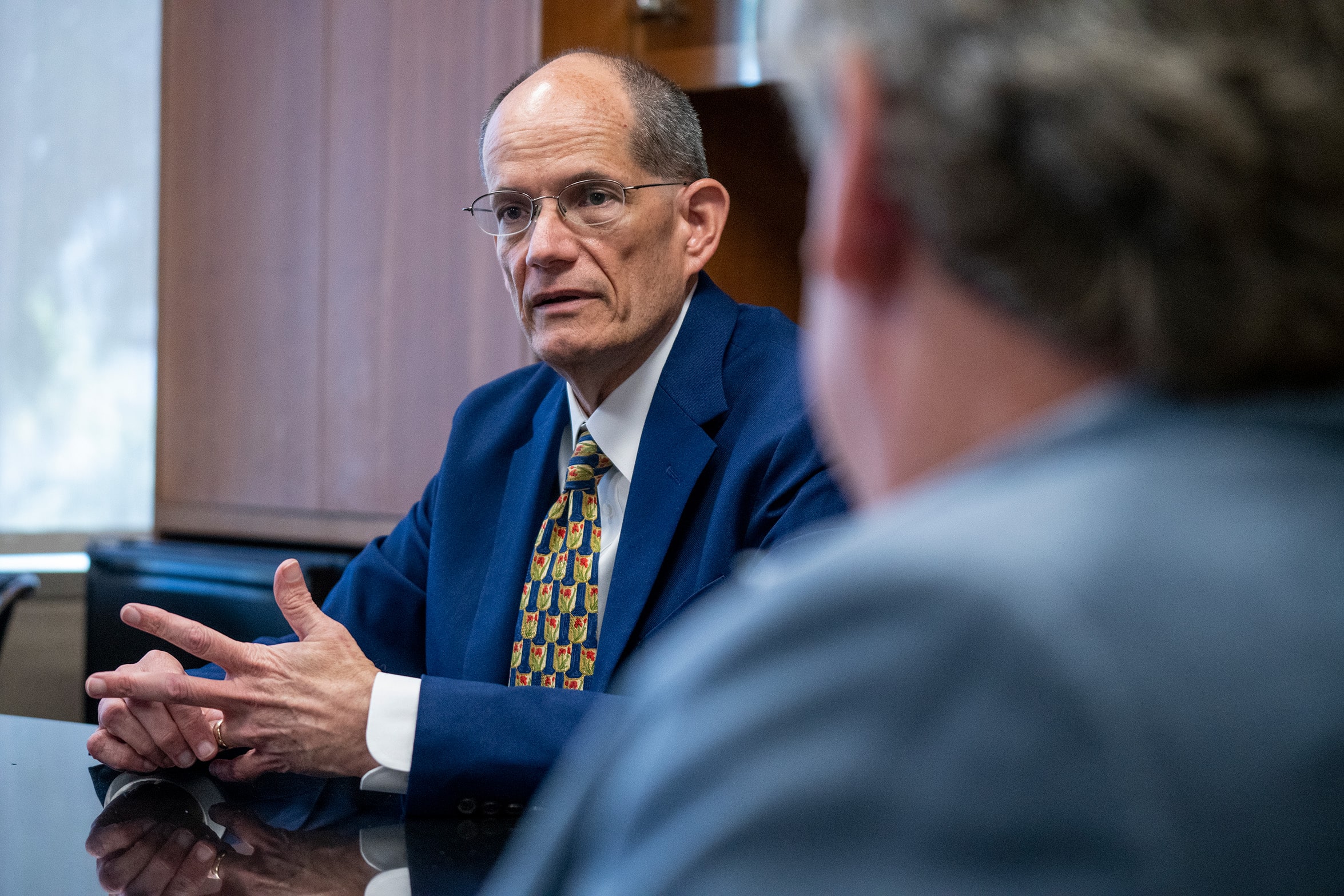An in-depth conversation with Barry Issenberg, current President of SSH, on his passions, pathway to leadership, and future aspirations for the society and healthcare education.
We sat down with Barry Issenberg, the current President of the Society for Simulation in Healthcare (SSH). With a story that begins in a simulation lab in the 1980s and winds through an impressive career dedicated to healthcare education, Barry’s journey is nothing short of a blockbuster. As the Michael S. Gordon Chair of Medical Education, a tenured Professor of Medicine, and Director of the Gordon Center for Simulation and Innovation at the University of Miami, Dr. Issenberg’s work spans the research, development, implementation, and evaluation of groundbreaking training and assessment systems. In this lively chat, Barry talks about his strategic vision for SSH, the transformative role of simulation in healthcare education, patient safety, and the challenges and opportunities that lie ahead. This conversation not only sheds light on Barry’s personal and professional journey but also highlights the strategic initiatives and future directions of SSH.
Barry Issenberg

Barry Issenberg, MD, the Michael S. Gordon Chair of Medical Education and tenured Professor of Medicine, and Director of the Gordon Center for Simulation and Innovation at the University of Miami. His career has focused on the research, development, implementation, and evaluation of innovative training and evaluation systems.
Hi Barry, thanks for accepting to share some time and thoughts with us. Please tell us about why you entered the field of healthcare simulation.
I was first introduced to healthcare simulation when I was 14 years-old and my mother joined Dr. Michael Gordon’s University of Miami (UM) simulation laboratory in 1982. I already had an interest in medicine and grew up developing video games and computer software programs. The lab became a magical place where I spent my free time during high school and college volunteering, and then working on various simulation technology projects. My dedicated interest in simulation began strengthening during medical school at UM when I became increasingly frustrated with spending all day listening to lectures with no patient contact. I took a year off of medical school after my 2nd year and immersed myself working with Michael Gordon’s team in developing and evaluating simulation-based healthcare curricula. Finally, during my internal medicine residency in the 1990’s, I could see that simulation was about to be adopted widely in healthcare and wanted to be part of that transformation.

Can you share with readers when you joined the Society for Simulation in Healthcare (SSH) and what inspired you to get involved with the organization?
From 2003 to 2005, I collaborated with colleagues on a Best Evidence Medical Education (BEME) review, focusing on simulation features that promote effective learning. Our objective was to publish our findings in the Spring 2005 issue of Medical Teacher. In late 2004, the SSH, then known as the SSM, invited me to present at its annual meeting in Miami. This marked my first external presentation of our BEME review findings, attracting a large, engaged audience in a packed hotel conference room. The overwhelming interest and my subsequent reflection on the event signaled a pivotal moment in my career, highlighting a newfound community for my professional interests and growth. Following this, I received invitations to several leadership roles related to research and scholarship, eventually leading to my co-chair position for the 2008 annual meeting. This journey not only marked significant milestones in my professional development but also reinforced the value of our research within the healthcare simulation community.
What made you want to run for President of SSH?
For over twenty years, I’ve served in various roles within the SSH, adopting a servant leadership style that has offered me a comprehensive view of its mission and the collaborative, consensus-driven approach vital for serving its members effectively. My tenure in senior leadership positions at my institution has broadened my understanding of the diverse needs and challenges across professions and specialties. This experience has deepened my appreciation for interdisciplinary teamwork, involving collaborations with nursing, engineering, and humanities colleagues. I have consistently promoted diversity, trust, inclusion, and leadership development in every role. These principles have not only guided my professional journey but have also prepared me to contribute meaningfully to the SSH, an organization central to my career. My aim has been to leverage my experiences to benefit and enrich the SSH community, reflecting my commitment to give back and support its growth.

What do you plan to focus your efforts on as current SSH President?
As president, I aim to leverage my leadership experience to guide the SSH in broadening its impact on global healthcare quality. This involves a mindful approach to ensure the SSH mirrors the diverse backgrounds and ideas of its expanding membership. Embracing a transdisciplinary strategy is essential for advancing research, innovation, and education, alongside promoting professional and leadership growth among members. Given the complexity of today’s global challenges, the SSH must lead in addressing long standing issues, especially in enhancing patient safety and healthcare quality through simulation. This necessitates not only strengthening ties with traditional healthcare academia but also building strategic collaborations with national and international governmental and industry entities dedicated to delivering safe, quality healthcare. My vision includes fostering these relationships to position the SSH as a pivotal force in solving critical healthcare challenges, thereby maximizing its contribution to society.
In the long term, what is your vision of the future of SSH?
By fostering strategic partnerships across healthcare academia, affiliated simulation organizations, governmental bodies, and industry, the SSH needs to address the complex challenges of patient safety and healthcare quality head-on. The focus will be on advancing research, promoting cutting-edge innovation, and supporting the professional development of its members. In doing so, the SSH will not only remain at the forefront of simulation in healthcare but also significantly contribute to shaping the future of global healthcare delivery. Looking forward, I envision a future where healthcare simulation not only enhances clinical skills and patient safety but also plays a crucial role in predictive analytics and personalized medicine, tailoring healthcare solutions to individual needs. By integrating innovative technologies such as artificial intelligence, the SSH will open new horizons in training, making simulation an indispensable tool in the evolution of healthcare systems worldwide. This vision commits to excellence, collaboration, and a dedication to transforming healthcare outcomes through the power of simulation.

In the SSH strategic plan, advocacy is one of the main pillars. What are you doing at the national and international level?
One goal within the advocacy pillar is to work globally with simulation-based and professional specialty societies, enhancing awareness of healthcare simulation’s impact on education, training, and clinical outcomes. The SSH takes pride in its collaboration with SESAM, aiming to create a global consensus statement on simulation practice. This initiative seeks to elevate awareness at local, national, and international levels about the effective application of simulation in education, research, and patient care. The SSH Asia Pacific Evolution Summit (SHAPES) was a recent event that brought together leaders from affiliated simulation organizations across the Asia Pacific region. Key advocacy areas include workforce development, upskilling healthcare workers, implementing and expanding competency-based education, and promoting interprofessional education. Additionally, the SSH is actively engaging with partner organizations to establish formal simulation-specific job classifications with the US Department of Labor. This effort is aimed at fostering recognition and support for a professional simulation workforce.
Recently, there has been considerable discussion regarding the establishment of competence benchmarks or ‘credentialing’, particularly in fields like healthcare. What is your perspective on setting these standards? Furthermore, how do you believe such measures could influence the overall quality of healthcare provision?
Setting standards and credentials in healthcare simulation is vital for ensuring quality, consistency, and effectiveness in simulation-based education, directly impacting patient care and safety. These benchmarks guarantee that simulation programs across various institutions follow best practices, enhancing the skills and decision-making abilities of healthcare professionals. Furthermore, credentials recognize individuals’ expertise in simulation, encouraging their professional development and commitment to excellence. Standards also drive innovation by defining quality and effectiveness criteria, fostering research into new simulation technologies and methodologies. Additionally, adherence to these benchmarks facilitates accreditation and funding opportunities, essential for the sustainability and growth of simulation programs. Ultimately, setting standards and credentials supports global collaboration, sharing of best practices, and continuous improvement in healthcare simulation, contributing to improved healthcare outcomes worldwide.
We always talk about standards and how working toward certain elements of the standards may have a positive impact in different business sectors. But why don’t we talk about standards of simulation devices or softwares?
Addressing this crucial issue requires collaboration. Industry, government agencies, and academia must partner to ensure the development and application of standards that maximize benefits for end users. These standards fulfill essential roles, including interoperability, enabling equipment from different manufacturers to integrate seamlessly for more complex and holistic simulation scenarios that accurately represent the diverse aspects of patient care. Standards assist educators in selecting and applying devices and software that align closely with their educational goals, thus elevating the instructional quality of simulations. Moreover, compliance with standards related to healthcare practices ensures adherence to regulatory requirements, mitigating legal risks and bolstering the legitimacy of simulation programs. Additionally, standards guide educational institutions and healthcare organizations in making informed procurement choices, securing cost-effective investments in simulation technology. The SSH is actively working to bridge this gap through its Future of Simulation Technology Summit at the 2025 IMSH, alongside a companion white paper dedicated to addressing this issue.
The IMSH24 in San Diego were intense but rewarding days. What is your final evaluation of the conference?
The SSH staff, IMSH co-chairs, and other members are actively conducting the final evaluation of the conference, which will be utilized to inform IMSH 2025 and future events. The objectives of the IMSH are to unite members of the global healthcare simulation community across all professions and disciplines – from first-time attendees to simulation pioneers. This inclusivity extends to our partners from industry, governmental agencies, and foundations. Another goal is to showcase the latest innovations and best practices in healthcare simulation. By all measures, including the number of attendees, exhibitors, and sessions, this was the largest and most successful IMSH to date. Beyond the quantifiable achievements, there was a tangible positive energy and a shared sense of enthusiasm and purpose for advancing healthcare simulation. My message is to build on this fantastic start to 2024 and commit to advocating for simulation in healthcare training, demonstrating its pivotal role in enhancing learning and improving patient outcomes. I encourage everyone to become ambassadors for this cause, sharing your experiences and insights both within and beyond the IMSH, to bridge the gap between simulated environments and real-world clinical excellence, and generate a global impact.

In San Diego we saw more and more VR, AR, artificial intelligence, new materials, etc…. What role does innovation play in the advancement of simulation as a patient safety tool?
These innovations are pivotal in advancing simulation as a crucial patient safety tool, transforming training with realistic, immersive experiences. AI enhances simulation training by creating dynamic, intelligent scenarios that adapt in real-time to the learner’s actions, offering a highly personalized training experience. This adaptability ensures that healthcare professionals can practice a wide range of clinical skills with feedback tailored to their learning progress and specific needs. Extended Reality (XR), encompassing VR, AR, and MR, bring additional levels of realism and immersion to simulation training. These technologies collectively extend the accessibility of high-quality simulation training, breaking down geographical and physical barriers. Healthcare professionals can engage in simulation training remotely, ensuring continuous education and skill development regardless of location. Furthermore, AI-driven analytics within traditional and newer simulations offer detailed performance analysis, allowing educators to identify specific areas for improvement and measure competency over time. This data-driven approach ensures that training is both evidence-based and outcome-focused, directly contributing to improved patient care practices.
As a researcher, what are, in your opinion, the most significant challenges facing simulation research today? and how is SSH working to address these challenges?
A persistent challenge in demonstrating the direct impact of simulation training on patient outcomes lies in the difficulty of translating educational outcomes into clinical practice improvements. The 2023 Research Summit and the recent publication of guidelines for simulation training, based on systematic, evidence-based reviews, are efforts by the SSH to address this. These guidelines aim to facilitate the implementation of longitudinal and multi-institutional studies that can trace the long-term effects of simulation training on clinical performance and patient care. This effort includes the development of standardized metrics for effectiveness evaluation across various settings and disciplines, enabling more comprehensive analyses. Support for this initiative comes from the SSH’s International Simulation Data Registry, which collects and archives standardized data from simulation-based educational activities worldwide. Another challenge is the sustained funding necessary for supporting the costs of multi-institutional, longitudinal research studies. To address this, the SSH has established a new SSH Fund to support Society Research Awards, which will benefit early career researchers, experienced researchers, and crucially, multi-institutional research efforts.
To conclude, what has been your proudest achievement in your career so far?
I do not have any proud moments of personal achievement in my professional career yet as there is still too much that needs to be done for healthcare simulation to come close to realizing its potential of making a real impact on the delivery of healthcare and on the lives of patients. Ask me again in 10 years. 😊
Thank you very much, Barry. We appreciate your time and the information you’ve shared with us today. Your contributions to advancing healthcare simulation are invaluable, and it’s clear that under your guidance, SSH will continue to play a pivotal role in improving healthcare education and patient care. We hope to see you again, maybe this time in Europe.
READ ALSO











































